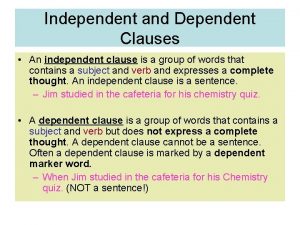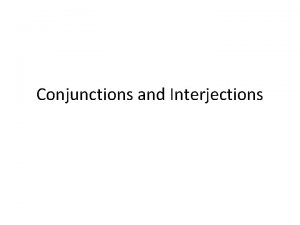GREEK CONJUNCTIONS Conjunctions n n n A conjunction











- Slides: 11

GREEK CONJUNCTIONS

Conjunctions n n n A conjunction joins together two or more words, phrases, clauses, or sentences. They can also be used to join together similar things (“and, also”). Furthermore, they are also used to contrast different items ("but, " "however“). Greek conjunctions are much like conjunctions in English. Typically they do not change forms (i. e. , they undergo no declension).

Following is a list of conjunctions commonly found in the NT n Prayerfully consider this, and learn…

kai (και), “and, even, also” n n n By far the most common, and is most often translated "and. " This connects words, phrases, or sentences together. It’s significant use is in 1 Timothy 3: 16. The use of kai, “and, ” tells us that there is a vital connection between the church described in verse 15 and "the mystery of godliness" described in verse 16, and that the two ideas are tied together in the mind of Paul. Kai can also be translated "also" or "even. " But it is most commonly translated "and. "

hina (ινα), “that, in order that, so that” Most commonly used to denote PURPOSE. n Often can be translated "that" or "in order that. " n Matthew 7: 1 n 2 Corinthians 5: 15. n

gar (γαρ), “for” This is most frequently used to give a reason or an explanation for what has just been said. n See how it is used in Matthew 1: 21. n Paul would often use this conjunction (see Romans 10: 2, 3, 4, 5, 10, 11, 12, 13, etc. ). n

oun (ουν), “therefore, consequently” n n n n Most often an inferential conjunction and is translated as "therefore, consequently. " If a writer uses this, it is understood that he is making an inference, or a conclusion, in the light of what he has just said. Examples: Ephesians 4: 1, a conclusion based on the first three chapters Romans 12: 1, a conclusion based on the first 11 chapters James 4: 4, a conclusion based on the first half of the verse Romans 3: 28, conclusion based on his argument in chapter 3

alla (αλλα), “but, yet, rather, nevertheless, certainly” n n n A strong adversative conjunction and one of the strongest ways the Greeks could say, “but. ” Often expresses a strong contrast. See Matthew 4: 4; 2 Corinthians 4: 8 and Titus 3: 5. In some contexts, it can be translated as "yet, rather, nevertheless, certainly, etc. " Most often it is translated "but. "

de (δε), “but, however, yet, on the other hand” n n This is another adversative conjunction, perhaps somewhat milder than αλλα, but also meaning "but, however, yet, on the other hand. " See Romans 6: 23; Ephesians 2: 4; Titus 3: 4. However, this word is also used without the adversative meaning and can simply be translated "and" or "now, " etc.

hoti (οτι), “for, because” Commonly used as a causal particle and means, "because" or "for. " n In this sense it occurs in each one of the beatitudes (Matthew 5: 3 ff). n Answers the question "WHY? ". n

dio, διο, “therefore, for this reason, also” The strongest inferential conjunction. n Is often translated “therefore, ” “for this cause, or reason, ” “also. ” n
 List of subordinate conjunctions
List of subordinate conjunctions Is therefore a conjunction
Is therefore a conjunction Ancient greek conjunctions
Ancient greek conjunctions What is the greek miracle in greek mythology
What is the greek miracle in greek mythology A series without a conjunction examples
A series without a conjunction examples Is it a conjunction or preposition
Is it a conjunction or preposition Conjunction assessment
Conjunction assessment What is a conjunction word
What is a conjunction word Conjunction fallacy psychology
Conjunction fallacy psychology Conjunction rule
Conjunction rule Dependent clause examples
Dependent clause examples Contoh soal konjungsi
Contoh soal konjungsi





















